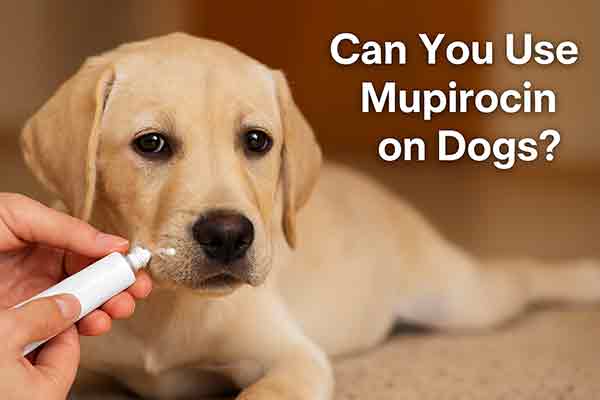Can You Use Mupirocin on Dogs? | A Pet Owner’s Guide to Mupirocin Use
Table of Contents
- Introduction
- What Is Mupirocin?
- Can You Use Mupirocin on Dogs?
- How Mupirocin Works for Canine Skin Infections
- Conditions Mupirocin Can Treat in Dogs
- Veterinary Approval and Proper Dosage
- How to Safely Apply Mupirocin on Dogs
- Possible Side Effects and Precautions
- Alternatives to Mupirocin for Dogs
- Conclusion
Introduction
If your dog is dealing with a skin infection, hot spot, or wound, you may be wondering: Can you use mupirocin on dogs? This topical antibiotic is widely used in human medicine, but is it safe and effective for your canine companion? In this guide, we’ll cover everything you need to know about using mupirocin for dogs, from benefits and applications to safety tips and veterinary recommendations.
What Is Mupirocin?
Mupirocin (brand name: Bactroban) is a topical antibiotic used to treat bacterial skin infections. It works by inhibiting the synthesis of bacterial proteins, thereby eliminating harmful bacteria like Staphylococcus aureus and Streptococcus species. Mupirocin is available in ointment and cream forms and is commonly prescribed to treat minor wounds, infected cuts, impetigo, and folliculitis in humans.
Can You Use Mupirocin on Dogs?
Yes—but only under veterinary supervision. Mupirocin is not FDA-approved for veterinary use, but many veterinarians prescribe it off-label to treat localized skin infections in dogs. It’s generally safe when used in small quantities and for short periods. However, misuse or overuse can lead to complications, especially if your dog licks or ingests the ointment.
How Mupirocin Works for Canine Skin Infections
When applied topically, mupirocin penetrates the skin and inhibits bacterial protein synthesis. This prevents the bacteria from reproducing, allowing the dog’s immune system and skin to heal. Mupirocin is especially effective against gram-positive bacteria, including strains resistant to other antibiotics.
Conditions Mupirocin Can Treat in Dogs
Veterinarians may recommend mupirocin for treating:
- Hot spots: Also known as acute moist dermatitis, caused by scratching or chewing
- Superficial bacterial infections: Like pyoderma or minor abscesses
- Wound infections: To prevent or treat mild bacterial contamination
- Interdigital cysts: Inflamed or infected bumps between toes
- Minor surgical site infections: Post-operative wound care
Veterinary Approval and Proper Dosage
Even though mupirocin is available over the counter in some countries, you should never use it on your dog without veterinary approval. The appropriate dosage depends on the size of the wound, the dog’s weight, and the severity of the infection. A veterinarian will guide you on:
- How much to apply
- How frequently to reapply (usually 1–3 times per day)
- How long the course of treatment should last
In many cases, veterinarians may prescribe mupirocin alongside oral antibiotics or anti-inflammatories to address deeper infections.
How to Safely Apply Mupirocin on Dogs
Follow these steps when applying mupirocin on your dog:
- Clean the area: Use a mild antiseptic or warm water to gently clean the wound.
- Dry thoroughly: Pat the area dry to ensure the ointment adheres well.
- Apply a thin layer: Use a gloved hand or cotton swab to apply mupirocin to the affected area.
- Prevent licking: Use an Elizabethan collar (cone) or bandage to prevent your dog from licking the ointment.
- Wash hands after: Prevent potential spread of bacteria or residue.
Possible Side Effects and Precautions
Mupirocin is usually well-tolerated, but like any medication, it can cause side effects in some dogs:
- Allergic reactions: Redness, swelling, or itching at the application site
- Gastrointestinal upset: If ingested, can cause vomiting or diarrhea
- Toxicity: Rare but possible if used in large amounts or over long periods
Always monitor your dog after applying a new medication and contact your vet if you notice adverse reactions.
Alternatives to Mupirocin for Dogs
If your dog reacts poorly to mupirocin or if your vet deems it unsuitable, there are several alternatives:
- Veterinary-formulated topical antibiotics: Like Animax, Vetropolycin, or Gentamicin sprays
- Natural options: Such as manuka honey or chlorhexidine-based cleansers
- Oral antibiotics: For deeper or systemic infections
- Anti-itch creams: To prevent scratching and worsening of the infection
Your vet will consider your dog’s health, age, and allergy history before suggesting an alternative.
Conclusion
Can you use mupirocin on dogs? The answer is yes, but only with guidance from your veterinarian. Mupirocin can be an effective treatment for minor skin infections, wounds, and hot spots when used correctly. However, misuse can cause complications, and some infections require stronger or systemic treatments. Always consult your vet before applying any human medication to your dog, and follow all usage instructions carefully.
For more helpful tips on canine health, wound care, and safe medication use, check out our blog and subscribe to receive trusted pet care insights directly to your inbox.







